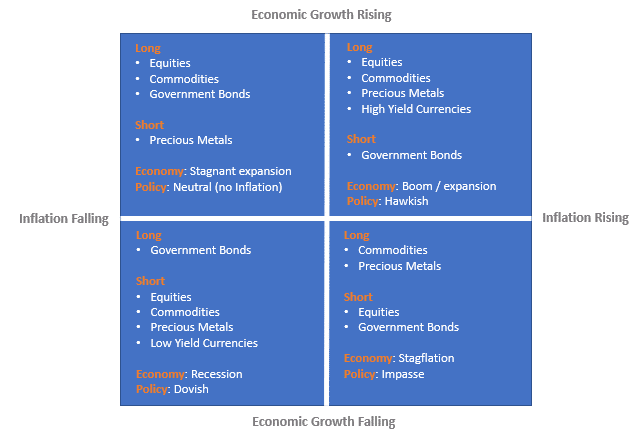Belgium macroeconomic model analysis
The two most important economic indicators of the Belgium economy are real economic growth expectations and inflation. MacroVar uses Belgium Manufacturing ESI Order Books to gauge economic growth expectations and Belgium Manufacturing ESI Selling Price expectations of next months to gauge inflation expectations. Belgium's economy is healthy when it generates stable economic growth with low inflation. Policymakers (the government and the central bank) use fiscal and monetary policy to inject liquidity during slowdowns (to solve weak economic growth) and withdraw liquidity from an overheating economy (to solve high inflation).
The four economic environments
There are 4 economic environments based on economic growth and inflationary conditions. Financial assets are affected by economic growth and inflation expectations as explained in the diagram below.
- Inflation boom: Accelerating Economic growth with Rising inflation - Monetary Policy response: Hawkish
- Stagflation: Slowing Economic Growth with Rising Inflation - Monetary Policy response: Dilemma
- Disinflation boom: Accelerating Economic growth with Slowing Inflation - Monetary Policy response: Neutral
- Deflation Bust: : Slowing Economic Growth with Falling Inflation - Monetary Policy response: Dovish
Belgium Economy
Belgium is a country located in western Europe with a population of about 11 million people. It has a developed, high-income economy that is ranked as the 22nd-largest in the world.The Belgian economy is a mixed economy, meaning it combines elements of a market economy with a planned economy. The government plays a significant role in the economy through state-owned enterprises and other forms of regulation, but there is also a significant private sector.
The main sectors of the Belgian economy include industry, agriculture, and services.
- Industry: Industry is a major contributor to the Belgian economy, accounting for about 20% of the country's GDP. Major industries include manufacturing, construction, and mining. Belgium is known for its advanced manufacturing sector, which produces a wide range of goods including automobiles, machinery, and chemicals.
- Agriculture: Agriculture is a relatively small sector of the Belgian economy, employing about 2% of the population. Major agricultural products include grains, vegetables, and fruit.
- Services: The service sector in Belgium is growing and now accounts for about 80% of the country's GDP. This sector includes financial services, real estate, and tourism.